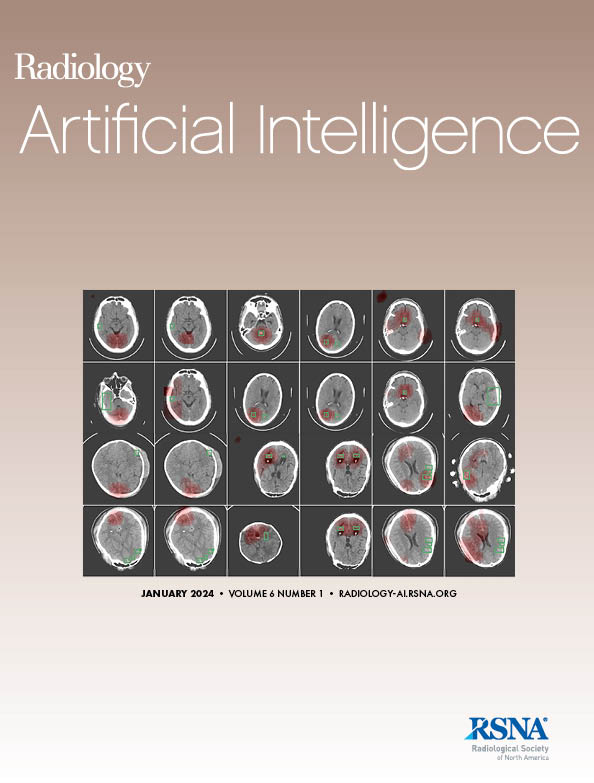Joon Jang, Kyu Sung Choi, Junhyeok Lee, Hyochul Lee, Inpyeong Hwang, Jung Hyun Park, Jin Wook Chung, Seung Hong Choi, Hyeonjin Kim
求助PDF
{"title":"无监督深度学习在弥漫性胶质瘤血脑屏障渗漏检测中的应用。","authors":"Joon Jang, Kyu Sung Choi, Junhyeok Lee, Hyochul Lee, Inpyeong Hwang, Jung Hyun Park, Jin Wook Chung, Seung Hong Choi, Hyeonjin Kim","doi":"10.1148/ryai.240507","DOIUrl":null,"url":null,"abstract":"<p><p>Purpose To develop an unsupervised deep learning framework for generalizable blood-brain barrier leakage detection using dynamic contrast-enhanced MRI, without requiring pharmacokinetic models and arterial input function estimation. Materials and Methods This retrospective study included data from patients who underwent dynamic contrast-enhanced MRI between April 2010 and December 2020. An autoencoder-based anomaly detection approach identified one-dimensional voxel-wise time-series abnormal signals through reconstruction residuals, separating them into residual leakage signals (RLSs) and residual vascular signals. The RLS maps were evaluated and compared with the volume transfer constant (<i>K</i><sup>trans</sup>) using the structural similarity index and correlation coefficient. Generalizability was tested on subsampled data, and isocitrate dehydrogenase (<i>IDH</i>) status classification performance was assessed using area under the receiver operating characteristic curve (AUC). Results A total of 274 patients (mean age, 54.4 years ± 14.6 [SD]; 164 male) were included in the study. RLS showed high structural similarity (structural similarity index, 0.91 ± 0.02) and correlation (<i>r</i> = 0.56; <i>P</i> < .001) with <i>K</i><sup>trans</sup>. On subsampled data, RLS maps showed better correlation with RLS values from the original data (0.89 vs 0.72; <i>P</i> < .001), higher peak signal-to-noise ratio (33.09 dB vs 28.94 dB; <i>P</i> < .001), and higher structural similarity index (0.92 vs 0.87; <i>P</i> < .001) compared with <i>K</i><sup>trans</sup> maps. RLS maps also outperformed <i>K</i><sup>trans</sup> maps in predicting <i>IDH</i> mutation status (AUC, 0.87 [95% CI: 0.83, 0.91] vs 0.81 [95% CI: 0.76, 0.85]; <i>P</i> = .02). Conclusion The unsupervised framework effectively detected blood-brain barrier leakage without pharmacokinetic models and arterial input function. <b>Keywords:</b> Dynamic Contrast-enhanced MRI, Unsupervised Learning, Feature Detection, Blood-Brain Barrier Leakage Detection <i>Supplemental material is available for this article.</i> © RSNA, 2025 See also commentary by Júdice de Mattos Farina and Kuriki in this issue.</p>","PeriodicalId":29787,"journal":{"name":"Radiology-Artificial Intelligence","volume":" ","pages":"e240507"},"PeriodicalIF":13.2000,"publicationDate":"2025-05-01","publicationTypes":"Journal Article","fieldsOfStudy":null,"isOpenAccess":false,"openAccessPdf":"","citationCount":"0","resultStr":"{\"title\":\"Unsupervised Deep Learning for Blood-Brain Barrier Leakage Detection in Diffuse Glioma Using Dynamic Contrast-enhanced MRI.\",\"authors\":\"Joon Jang, Kyu Sung Choi, Junhyeok Lee, Hyochul Lee, Inpyeong Hwang, Jung Hyun Park, Jin Wook Chung, Seung Hong Choi, Hyeonjin Kim\",\"doi\":\"10.1148/ryai.240507\",\"DOIUrl\":null,\"url\":null,\"abstract\":\"<p><p>Purpose To develop an unsupervised deep learning framework for generalizable blood-brain barrier leakage detection using dynamic contrast-enhanced MRI, without requiring pharmacokinetic models and arterial input function estimation. Materials and Methods This retrospective study included data from patients who underwent dynamic contrast-enhanced MRI between April 2010 and December 2020. An autoencoder-based anomaly detection approach identified one-dimensional voxel-wise time-series abnormal signals through reconstruction residuals, separating them into residual leakage signals (RLSs) and residual vascular signals. The RLS maps were evaluated and compared with the volume transfer constant (<i>K</i><sup>trans</sup>) using the structural similarity index and correlation coefficient. Generalizability was tested on subsampled data, and isocitrate dehydrogenase (<i>IDH</i>) status classification performance was assessed using area under the receiver operating characteristic curve (AUC). Results A total of 274 patients (mean age, 54.4 years ± 14.6 [SD]; 164 male) were included in the study. RLS showed high structural similarity (structural similarity index, 0.91 ± 0.02) and correlation (<i>r</i> = 0.56; <i>P</i> < .001) with <i>K</i><sup>trans</sup>. On subsampled data, RLS maps showed better correlation with RLS values from the original data (0.89 vs 0.72; <i>P</i> < .001), higher peak signal-to-noise ratio (33.09 dB vs 28.94 dB; <i>P</i> < .001), and higher structural similarity index (0.92 vs 0.87; <i>P</i> < .001) compared with <i>K</i><sup>trans</sup> maps. RLS maps also outperformed <i>K</i><sup>trans</sup> maps in predicting <i>IDH</i> mutation status (AUC, 0.87 [95% CI: 0.83, 0.91] vs 0.81 [95% CI: 0.76, 0.85]; <i>P</i> = .02). Conclusion The unsupervised framework effectively detected blood-brain barrier leakage without pharmacokinetic models and arterial input function. <b>Keywords:</b> Dynamic Contrast-enhanced MRI, Unsupervised Learning, Feature Detection, Blood-Brain Barrier Leakage Detection <i>Supplemental material is available for this article.</i> © RSNA, 2025 See also commentary by Júdice de Mattos Farina and Kuriki in this issue.</p>\",\"PeriodicalId\":29787,\"journal\":{\"name\":\"Radiology-Artificial Intelligence\",\"volume\":\" \",\"pages\":\"e240507\"},\"PeriodicalIF\":13.2000,\"publicationDate\":\"2025-05-01\",\"publicationTypes\":\"Journal Article\",\"fieldsOfStudy\":null,\"isOpenAccess\":false,\"openAccessPdf\":\"\",\"citationCount\":\"0\",\"resultStr\":null,\"platform\":\"Semanticscholar\",\"paperid\":null,\"PeriodicalName\":\"Radiology-Artificial Intelligence\",\"FirstCategoryId\":\"1085\",\"ListUrlMain\":\"https://doi.org/10.1148/ryai.240507\",\"RegionNum\":0,\"RegionCategory\":null,\"ArticlePicture\":[],\"TitleCN\":null,\"AbstractTextCN\":null,\"PMCID\":null,\"EPubDate\":\"\",\"PubModel\":\"\",\"JCR\":\"Q1\",\"JCRName\":\"COMPUTER SCIENCE, ARTIFICIAL INTELLIGENCE\",\"Score\":null,\"Total\":0}","platform":"Semanticscholar","paperid":null,"PeriodicalName":"Radiology-Artificial Intelligence","FirstCategoryId":"1085","ListUrlMain":"https://doi.org/10.1148/ryai.240507","RegionNum":0,"RegionCategory":null,"ArticlePicture":[],"TitleCN":null,"AbstractTextCN":null,"PMCID":null,"EPubDate":"","PubModel":"","JCR":"Q1","JCRName":"COMPUTER SCIENCE, ARTIFICIAL INTELLIGENCE","Score":null,"Total":0}
引用次数: 0
引用
批量引用

 求助内容:
求助内容: 应助结果提醒方式:
应助结果提醒方式:


